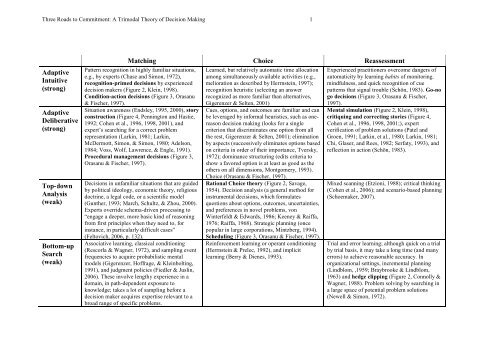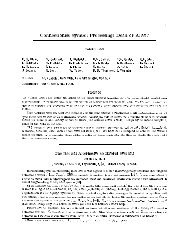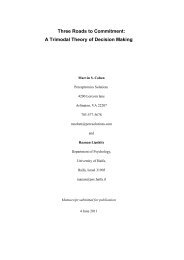Three Roads to Commitment: A Trimodal Theory of Decision Making
Three Roads to Commitment: A Trimodal Theory of Decision Making
Three Roads to Commitment: A Trimodal Theory of Decision Making
Create successful ePaper yourself
Turn your PDF publications into a flip-book with our unique Google optimized e-Paper software.
<strong>Three</strong> <strong>Roads</strong> <strong>to</strong> <strong>Commitment</strong>: A <strong>Trimodal</strong> <strong>Theory</strong> <strong>of</strong> <strong>Decision</strong> <strong>Making</strong> 1<br />
Adaptive<br />
Intuitive<br />
(strong)<br />
Adaptive<br />
Deliberative<br />
(strong)<br />
Top-down<br />
Analysis<br />
(weak)<br />
Bot<strong>to</strong>m-up<br />
Search<br />
(weak)<br />
Matching Choice Reassessment<br />
Pattern recognition in highly familiar situations,<br />
e.g., by experts (Chase and Simon, 1972),<br />
recognition-primed decisions by experienced<br />
decision makers (Figure 2, Klein, 1998).<br />
Condition-action decisions (Figure 3, Orasanu<br />
& Fischer, 1997).<br />
Situation awareness (Endsley, 1995, 2000), s<strong>to</strong>ry<br />
construction (Figure 4, Penning<strong>to</strong>n and Hastie,<br />
1992; Cohen et al., 1996, 1998, 2001), and<br />
expert’s searching for a correct problem<br />
representation (Larkin, 1981; Larkin,<br />
McDermott, Simon, & Simon, 1980; Adelson,<br />
1984; Voss, Wolf, Lawrence, & Engle, 1991).<br />
Procedural management decisions (Figure 3,<br />
Orasanu & Fischer, 1997).<br />
<strong>Decision</strong>s in unfamiliar situations that are guided<br />
by political ideology, economic theory, religious<br />
doctrine, a legal code, or a scientific model<br />
(Gunther, 1993; March, Schultz, & Zhou, 2000).<br />
Experts override schema-driven processing <strong>to</strong><br />
“engage a deeper, more basic kind <strong>of</strong> reasoning<br />
from first principles when they need <strong>to</strong>, for<br />
instance, in particularly difficult cases”<br />
(Fel<strong>to</strong>vich, 2006, p. 132).<br />
Associative learning, classical conditioning<br />
(Rescorla & Wagner, 1972), and sampling event<br />
frequencies <strong>to</strong> acquire probabilistic mental<br />
models (Gigerenzer, H<strong>of</strong>frage, & Kleinbolting,<br />
1991), and judgment policies (Fiedler & Juslin,<br />
2006). These involve lengthy experience in a<br />
domain, in path-dependent exposure <strong>to</strong><br />
knowledge; takes a lot <strong>of</strong> sampling before a<br />
decision maker acquires expertise relevant <strong>to</strong> a<br />
broad range <strong>of</strong> specific problems.<br />
Learned, but relatively au<strong>to</strong>matic time allocation<br />
among simultaneously available activities (e.g.,<br />
melioration as described by Herrnstein, 1997);<br />
recognition heuristic (selecting an answer<br />
recognized as more familiar than alternatives,<br />
Gigerenzer & Selten, 2001)<br />
Cues, options, and outcomes are familiar and can<br />
be leveraged by informal heuristics, such as onereason<br />
decision making (looks for a single<br />
criterion that discriminates one option from all<br />
the rest, Gigerenzer & Selten, 2001); elimination<br />
by aspects (successively eliminates options based<br />
on criteria in order <strong>of</strong> their importance, Tversky,<br />
1972); dominance structuring (edits criteria <strong>to</strong><br />
show a favored option is at least as good as the<br />
others on all dimensions, Montgomery, 1993).<br />
Choice (Orasanu & Fischer, 1997).<br />
Rational Choice theory (Figure 2, Savage,<br />
1954). <strong>Decision</strong> analysis (a general method for<br />
instrumental decisions, which formulates<br />
questions about options, outcomes, uncertainties,<br />
and preferences in novel problems, von<br />
Winterfeldt & Edwards, 1986; Keeney & Raiffa,<br />
1976; Raiffa, 1968). Strategic planning (once<br />
popular in large corporations, Mintzberg, 1994).<br />
Scheduling (Figure 3, Orasanu & Fischer, 1997).<br />
Reinforcement learning or operant conditioning<br />
(Herrnstein & Prelec, 1992), and implicit<br />
learning (Berry & Dienes, 1993).<br />
Experienced practitioners overcome dangers <strong>of</strong><br />
au<strong>to</strong>maticity by learning habits <strong>of</strong> moni<strong>to</strong>ring.<br />
mindfulness, and quick recognition <strong>of</strong> cue<br />
patterns that signal trouble (Schön, 1983). Go-no<br />
go decisions (Figure 3, Orasanu & Fischer,<br />
1997).<br />
Mental simulation (Figure 2, Klein, 1998),<br />
critiquing and correcting s<strong>to</strong>ries (Figure 4,<br />
Cohen et al., 1996, 1998, 2001;), expert<br />
verification <strong>of</strong> problem solutions (Patel and<br />
Groen, 1991; Larkin, et al., 1980; Larkin, 1981;<br />
Chi, Glaser, and Rees, 1982; Serfaty, 1993), and<br />
reflection in action (Schön, 1983).<br />
Mixed scanning (Etzioni, 1988); critical thinking<br />
(Cohen et al., 2006); and scenario-based planning<br />
(Schoemaker, 2007).<br />
Trial and error learning; although quick on a trial<br />
by trial basis, it may take a long time (and many<br />
errors) <strong>to</strong> achieve reasonable accuracy. In<br />
organizational settings, incremental planning<br />
(Lindblom, ,1959; Braybrooke & Lindblom,<br />
1963) and hedge clipping (Figure 2, Connolly &<br />
Wagner, 1988). Problem solving by searching in<br />
a large space <strong>of</strong> potential problem solutions<br />
(Newell & Simon, 1972).




